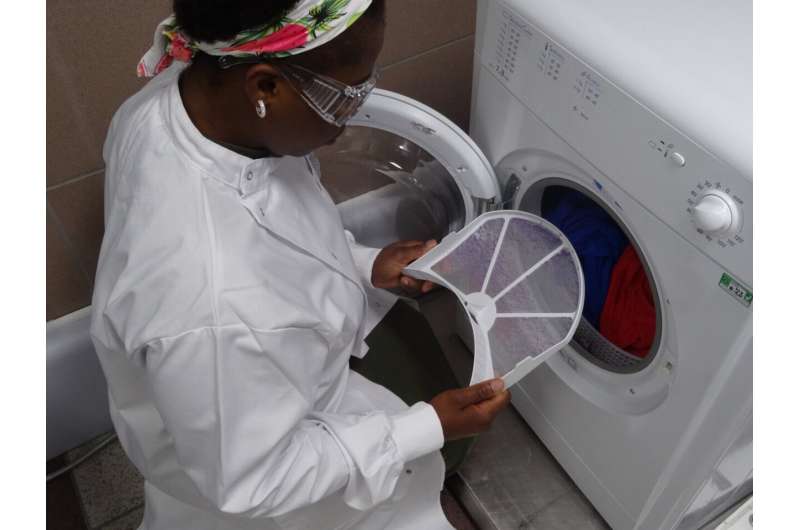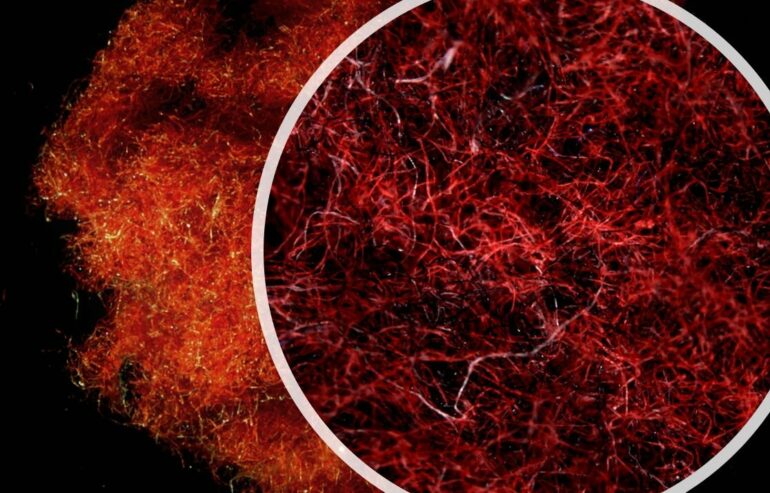A new analysis has found that tumble drying a load of laundry released microfibers into the air at a level comparable to the amount of microfibers released down the drain during machine washing of the same load—but fabric conditioners and lint filters with smaller pore size reduced release from dryers. Dr. Neil Lant and colleagues from Procter and Gamble and Northumbria University, U.K., present these findings in the open-access journal PLOS ONE on April 6, 2022.
Prior research has shown that clothes washing releases miniscule fragments of clothing, called microfibers, into the environment. Microfiber pollution poses risks for environmental and human health, and microfibers from clothing made of synthetic materials, such as polyester, pose greater risks because they biodegrade much more slowly than natural fibers, such as cotton or wool.
Much research into microfiber release during laundering has focused on microfibers released down the drain by washing machines, but less is understood about release from tumble dryers. To help clarify dryer microfiber release, Lant and colleagues measured release during washing and drying of laundry loads each consisting of 10 polyester T-shirts and 10 cotton T-shirts under typical North American and European domestic drying conditions.
By measuring microfibers released during washing, captured in lint filters, and released into air, the researchers found that domestic dryers produce far more microfibers than washing. While many fibers are captured in lint filters during drying, a significant amount is released into the air, comparable to the amount released down the drain in washing. Nonetheless, the research team found, lint filters were better at capturing polyester fibers than cotton fibers, so most microfibers released into air by dryers are likely to be cotton, they conclude.

Lint filter inspection from tumble dryer studies. © P&G
The analysis also found that the use of fabric conditioning products and dryer sheets, especially in combination, significantly reduced microfiber release from dryers. In addition, lint filters with smaller pore sizes significantly reduced microfiber release.
The scientists note that more research is needed to clarify the impact of microfibers released by tumble dryers. In light of their findings, they suggest several routes that dryer manufacturers and policy makers may consider to reduce such release, including improving lint filter design or switching to fully-sealed condenser dryers, which do not release fibers into the air.
The authors add: “Over 30 billion wash loads are tumble dried in vented dryers every year in North America—around 60,000 loads starting every minute, resulting in thousands of tons of fibers being released to the air annually. Our research found that airborne fiber pollution from dryers can be significantly reduced by improving the design of vented dryers or using fabric conditioning liquids or sheets. However, a move away from vented dryers to heat-pump condenser dryers is likely to be the best long-term solution as these don’t release any fibers to the air and are much more energy efficient.”
More information:
The impact of fabric conditioning products and lint filter pore size on airborne microfiber pollution arising from tumble drying, PLoS ONE (2022). DOI: 10.1371/journal.pone.0265912
Provided by
Public Library of Science
Citation:
Tumble dryers release microfibers into environment at levels comparable to washers (2022, April 6)



